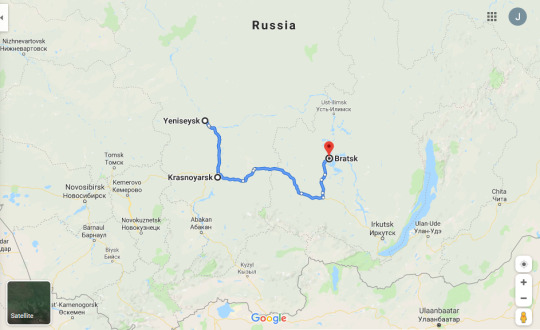#turukhansk
Explore tagged Tumblr posts
Text
Pendant to the shaman’s costume. Evenki

Ethnic groups
Evenki
Territory
East Siberia, Yenisei Guberniya, Turukhansk Krai
Date
втор. пол. XIX в.
Material
Metal: iron; leather
Number
РЭМ 730-52
Annotation
An anthropomorphic iron figurine with arms stretched sideways and holding a bow and an arrow. The figurine’s front is covered with coined linear ornament. Such figurine could be part of the “guard” (darisil) standing on the shaman’s river, near the border between the upper and nether worlds. The darisil prevented return of a ded person’s soul sent to the world of the dead.
#archeology#anthropology#history#lover#history lover#archeology lover#archive#archive collectiona#archeology archive
1 note
·
View note
Text
Siberian History (Part 7): Mangazeya
The Russian frontiersmen in Siberia still had to depend on Moscow for support (such as administrative & logistical support). During the Time of Troubles, the Siberian garrison was mostly left to themselves, which lead to disease, starvation and death.
The natives peoples of Siberia took the opportunity to make several attempts at an uprising. The most powerful was in 1608, when Princess Anna of Koda, a “Tartar Joan of Arc”, nearly succeeded in uniting the entire native population of Western Siberia to revolt.
In 1612, an attempt was made to re-establish the old Khanate of Sibir “as it had been in the time of Kuchum”. But it was betrayed at the last minute, and ten of its ringleaders were rounded up and hanged.
By now, the Russian occupation of the Ob-Irtysh Basin had increased the nation's size by a third. But in Moscow, Siberia still wasn't properly understood as a geographical entity, and so it was used as a political bargaining chip.
Boris Godunov, for example, tried get an influential boyar to support him against False Dmitry I, by promisng him “the Kingdoms of Kazan, Astrakhan, and all Siberia”. The False Dmitry II promised to reward his brother-in-law, a powerful Polish noble, with “the whole land of Siberia” for his help.
But the Ob-Irtysh Basin had scarcely been secured before the Russian advance into the next great river valley, the Yenisei, began.


The Russians ascended the eastern tributaries of the Ob River, and crossed a low plateau to streams flowing into the Yenisei. By 1619, they had taken all the important river routes and portages that connected those two rivers. They organized expeditions from Mangazeya (in the north) and Tomsk & Ketsk (in the south), coming at the river valley from both directions.

The Taz Estuary marks the area where Mangazeya was located.
They met the Tungu people on the lower Yenisei, and the Buryats (whom they'd never heard of before) on the upper Yenisei. The Buryats lived in a region that was rich in furs, and they practised animal husbandry; they were rumoured to grow crops and have access to silver. This was guaranteed to interest Russia.
The Tungu people (east of the Yenisei) and the Buryats (around Lake Baikal) fought to prevent Russia from establishing bases in their territory, but failed. Yeniseysk was founded in 1619 (where the Angara and Yenisei Rivers meet); Krasnoyarsk was founded in 1627 (astride cliffs of red-coloured marl); and Bratsk was founded in 1631 (on the Angara River).


On the upper Yenisei River (the southern part of it), the Russians met the staunch resistance of the Kyrgyz people and the Kalmuks, both steppe nomads. Their homelands bordered Siberia to the south, and they were continually hostile. Eventually, a solidly-fortified line was established over the southern frontier, but this would take two centuries.
Meanwhile, Russian mariners had developed the sea route north of Russia from Arkhangel to Mangazeya (which was just a few miles above the Arctic Circle). At Mangazeya, they bartered goods with the local Khanty and Samoyedic peoples for furs. Mangazeya prospered and grew, attracting more and more traders, who were willing to navigate the treacherous waters of the Kara Sea.
One contemporary account says that: “Hundreds of thousands of sable, ermine, silver and blue fox skins, and countless tons of precious mammoth and walrus ivory” were shipped every year from Mangazeya and Europe. This was an illicit trade that had begun during the Time of Troubles, and the government couldn't manage to gain control of it.
Porcelain, silk, and other expensive fabrics were traded (through middlemen) from Central Asia & China to Mangazeya. The city was “a virtual Baghdad of Siberia, where big commercial deals were celebrated at fabulous feasts that lasted for days, and that featured the best European wines and local delicacies like sturgeon, caviar, mushrooms, berries, and venison and other game.”
By the time stability was restored in Moscow, reports of Siberia's vast wealth in furs had spread far and wide. This, of course, attracted the attention and greed of European powers who wanted new colonies. The Russian government worried that foreign agents might try to trade directly with the natives, or even attempt an armed invasion (through the Taz Estuary) to seize the whole of north-western Siberia.
Meanwhile, inland merchants working out of the Urals, Tyumen and Tobolsk were envious of Mangazeya, as it siphoned off commerce that would otherwise have come to them.
So in 1619, the Russian government closed the sea route to Mangazeya. They forbade even Russians to use it, in case foreigners found it out from them. Anyone who broke this law was to be “put to the hardest possible death, and all their homes and families destroyed branch and root”.
Navigational markings were torn up. Surveillance posts were established along the coast, to intercept and kill anyone who tried to get through. A coastal fort was built on the Yamal Peninsula, commanding the portage between the Ob Gulf and the Kara Sea. Maps were falsified to depict Novaya Zemlya as a peninsula, rather than an island. This would cause problems for later mariners who were using them as nautical guides.
Gradually, Mangazeya declined, and the rich merchants left. In 1643, its administrative apparatus was moved to Turukhansk – this city was founded at the mouth of the Turukhan River, a tributary of the Yenisei. For a while, it was known as “New Mangazeya”.
In 1678, Mangazeya was burned to the ground, without any official explanation. The local Samoyedic peoples called its ruins Tagarevyhard, which means “destroyed town”. The site wouldn't be rediscovered for almost three centuries.
Mangazeya, perhaps more than any other early settlement, was the proof of the enormous wealth that Siberia possessed. In 1632, a former military governor of the district strongly encouraged the tsar to press on from the Yenisei to conquer the Lena River Basin. His encouragement was inspired by the riches of Mangazeya.
#book: east of the sun#history#military history#colonialism#economics#trade#native siberians#tungu people#buryats#kyrgyz people#kalmuks#khanty people#russia#khanate of sibir#siberia#yeniseysk#krasnoyarsk#bratsk#mangazeya#turukhansk#boris godunov#false dmitry ii
36 notes
·
View notes
Photo

Туруханск – бывший город. Один из старейших городов Сибири. Его основали седьмым по счету (после Тобольска, Тары, Томска и др) в 1657 году. Например, такие города как Красноярск, Иркутск и Якутск – основаны уже после Туруханска. •Нижняя Тунгуска-второй по величине правый приток Енисея, впадающий в него близ Туруханска. •Позже Туруханск стал местом ссылки множества людей. В том числе и известных. Например, именно там "сидел" Иосиф Сталин. А еще до него – Михаил Швабин, ставший героем повести Пушкина "Капитанская дочка" (там он описан как поручик Швабрин). Отбывал наказание в Туруханске и отец известного комедийного актера Савелия Крамарова. •Пика своего развития Туруханск достиг в 1989 году. Тогда в нем проживало свыше 8000 человек. На данный момент население поселка снизилось до 4600 и продолжает падать. •Рекорд холода в Туруханске –57*С. Летом воздух обычно не прогревается выше +15. Хотя, иногда бывает и жара до +30, но очень редко. #Turukhansk #Yenisei #Tunguska (at Туруханск) https://www.instagram.com/p/Chowx2sI4FwIIg0648kgI4cL7mo5dIVAaosaEk0/?igshid=NGJjMDIxMWI=
0 notes
Text
Accounting The Data And Localities Information Of Graphite!

The diamond-like element found in graphite reserves is an allotrope of carbon crystalline. Graphite has a hexagonal atomic structure and some unique properties.
The opaque, greyish-black material occurs as flexible scales, sheets, and also in large masses. Due to its granular or compact nature, graphite finds its application in the best graphite mining companies. Furthermore, it takes place from the metamorphosis of carbon sediments and their subsequent reaction with hydrothermal solutions. The primary striking feature of graphite is that it is most stable when kept under standard conditions.
Physical Properties of Graphite:
Graphite converts to diamond under high temperature and pressure. The looks vary largely from that of a diamond and are also at the other side of the hardness scale.
The bond between the six carbon atoms in graphite is the reason behind the softness of the material. Also, you can find wide spacious horizontal atomic sheets.
Pencils, lubricant, and battery industries contact the largest graphite mining industry owners to import generous quantities. Due to its high conductivity, it comes in the utilization of electronic products like solar panels and electrodes.
Chemical Properties Of Graphite:
The color varies from steel grey to black. The streak of graphite is mostly black. Additionally, it has a metallic luster that is also often earthy in nature.
The cleavage is perfect and unidirectional. Graphite has an opaque diaphaneity. The Mohs Hardness varies from 1 to 2 units and has a flexible tenacity. Moreover, the density of graphite ranges from .09 – 2.23 g/cm3.
Localities Distribution Of Graphite:
In the USA, there are large graphite reserves at Monroes, New York, Franklin, and Sterling Hills, Essex Co, Ticonderoga, and New Jersey. While numerous localities have access to graphite, only a few can afford optimum mining services.
In Russia, you find quality graphite at Nizhny Tunguski, Siberia, Shunga, along the banks of Yenisei River, and also in East Turukhansk. You also find large graphite mines around Amtara, Ratnapura, and parts of Sri Lanka.
In India, graphite occurrences are seen in Jammu and Kashmir, Jharkhand, Arunachal Pradesh, Gujarat, Karnataka, Maharashtra, and many more cities. This makes India a major producer of flake graphite.
Commercially relevant graphites in Canada have occurrences in Quebec, Grenville, at Buckingham, and also in parts adjacent to Ontario.
In Germany, graphite reserves are in Bavaria and Passau. In Finland, occurrences are in Pargas. In England, you will find graphite reserves at Barrodale, Cumbria, and also near Keswick.
Occurrences in Mexico take place at Sonora and Santa Maria due to the formation of graphite by the metamorphosis of the coal beds.
Conclusion:
Looking for quality and abundant graphite for your industry? Head over to Skamord Mining Company. Industries have great trust in them because they are among the best graphite mining companies. They follow ecologically viable practices that make the industry so popular. Visit their website to know more about them.
0 notes
Photo

Family shaman
Evenki, Yeniseysk Governorate, Turukhansk Region, beginning of XX century.
Russian Museum of Ethnography
19 notes
·
View notes
Text
Russian Actor- Vasilina Makovtseva
Russian Actor- Vasilina Makovtseva
Vasilina Makovtseva (Russian: Васили́на Ма́ковцева; November 14, 1977) is a Russian film and theatre actress, one of the leading figures at the Kolayda-Theatre where she worked since 2004. Makovtseva is best remembered for her leading part in Krotkaya (A gentle creature), which she represented at Cannes Film Festival in 2017.
Biography
Vasilina Makovtseva was born in Turukhansk, Krasnoyarsk…
View On WordPress
0 notes
Photo

Turukhansk District of Krasnoyarsk region in Eastern Siberia, close to the border with Yamalo-Nenets Autonomous Okrug, Russia. August 2013.
7 notes
·
View notes
Photo

🚢 т/х «В. Чкалов» — пассажирский речной трехпалубный теплоход, работающий на транспортной линии Красноярск — Дудинка — Красноярск на реке Енисей. Судно было построено в 1953 году в Германии по проекту 588 и поступило в Енисейское речное пароходство вместе с однотипным теплоходом «Александр Матросов», построенным на год позже. Длина судна — 96,3 метров, ширина — 14 метра, осадка — 2,45 м. Водоизмещение теплохода 1500 тонн, скорость до 23 км/час. #Krasnoyarsk #Lesosibirsk #Yeniseysk #Bor #Turukhansk #Igarka #Dudinka #Yenisei #Tunguska (at Krasnoyarsk Krai) https://www.instagram.com/p/Chovx7CoU6s2LhLCarUX3AtFznuiF9LXvRlCSw0/?igshid=NGJjMDIxMWI=
0 notes
Photo

Horse riding on deer
Evenki, Yeniseysk Governorate, Turukhansk Region, beginning of XX century.
Russian Museum of Ethnography
17 notes
·
View notes